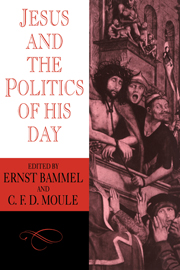Book contents
- Frontmatter
- Contents
- Abbreviations
- Foreword
- The Zealots and Jesus
- The revolution theory from Reimarus to Brandon
- The date and character of Mark
- Some observations on Tendenzkritik
- Argumentum e silentio
- The Poor and the Zealots
- The opposition between Jesus and Judaism
- Judaeo-Christianity and the Jewish establishment, A.D. 33–66
- A.D. 70 in Christian reflection
- The trial of Jesus in the Acta Pilati
- Christ as brigand in ancient anti-Christian polemic
- Jesus as a political agent in a version of the Josippon
- The Feeding of the Multitude
- The coin of ‘Render unto Caesar …’ (A note on some aspects of Mark 12: 13–17; Matt. 22: 15–22; Luke 20:20–26)
- Render to Caesar
- The Temple tax
- ‘Not peace but a sword’: Matt. 10:34ff; Luke 12: 51ff
- The decision of the Supreme Court to put Jesus to death (John 11:47–57) in its context: tradition and redaction in the Gospel of John
- The ‘triumphal’ entry
- The two swords (Luke 22: 35–38)
- The titulus
- Romans 13
- Biblical criticism criticised: with reference to the Markan report of Jesus's examination before the Sanhedrin
- The political charge against Jesus (Luke 23: 2)
- The trial before Pilate
- ‘His witness is true’: A test of the Johannine claim
- Index of Authors
- Index of References
The opposition between Jesus and Judaism
Published online by Cambridge University Press: 19 January 2010
- Frontmatter
- Contents
- Abbreviations
- Foreword
- The Zealots and Jesus
- The revolution theory from Reimarus to Brandon
- The date and character of Mark
- Some observations on Tendenzkritik
- Argumentum e silentio
- The Poor and the Zealots
- The opposition between Jesus and Judaism
- Judaeo-Christianity and the Jewish establishment, A.D. 33–66
- A.D. 70 in Christian reflection
- The trial of Jesus in the Acta Pilati
- Christ as brigand in ancient anti-Christian polemic
- Jesus as a political agent in a version of the Josippon
- The Feeding of the Multitude
- The coin of ‘Render unto Caesar …’ (A note on some aspects of Mark 12: 13–17; Matt. 22: 15–22; Luke 20:20–26)
- Render to Caesar
- The Temple tax
- ‘Not peace but a sword’: Matt. 10:34ff; Luke 12: 51ff
- The decision of the Supreme Court to put Jesus to death (John 11:47–57) in its context: tradition and redaction in the Gospel of John
- The ‘triumphal’ entry
- The two swords (Luke 22: 35–38)
- The titulus
- Romans 13
- Biblical criticism criticised: with reference to the Markan report of Jesus's examination before the Sanhedrin
- The political charge against Jesus (Luke 23: 2)
- The trial before Pilate
- ‘His witness is true’: A test of the Johannine claim
- Index of Authors
- Index of References
Summary
Jesus was a Jew. This indisputable fact long ago led H. S. Reimarus, the founder of the study of the historical Jesus, to regard Jesus completely within the framework of Judaism, and to consider it evident ‘that Jesus had not the slightest intention of doing away with the Jewish religion and putting another in its place’. From this it became necessary to explain the New Testament accounts of conflicts between Jesus and the Pharisees as the product of exchanges between church and synagogue – an early position which the form-critical approach has appeared to confirm. But if Jesus lived in harmony with his contemporaries, then the reason for his violent end must have lain in his political activity. Accordingly, from Reimarus to R. Eisler down to S. G. F. Brandon Jesus has again and again been placed in the company of Zealot resistance fighters.
Since the Enlightenment, too, the representation of Jesus as an Essene wisdom teacher has often been placed alongside representations of him as an orthodox Pharisee and a nationalistic resistance fighter. Since the publication of the Qumran texts particularly, repeated attempts have been made to connect Jesus with the Essenes.
Over against all these stands an impressive list of scholars who have taken seriously the opposition of Jesus to his contemporaries which comes to light in various places in the Gospels.
- Type
- Chapter
- Information
- Jesus and the Politics of his Day , pp. 129 - 144Publisher: Cambridge University PressPrint publication year: 1984



